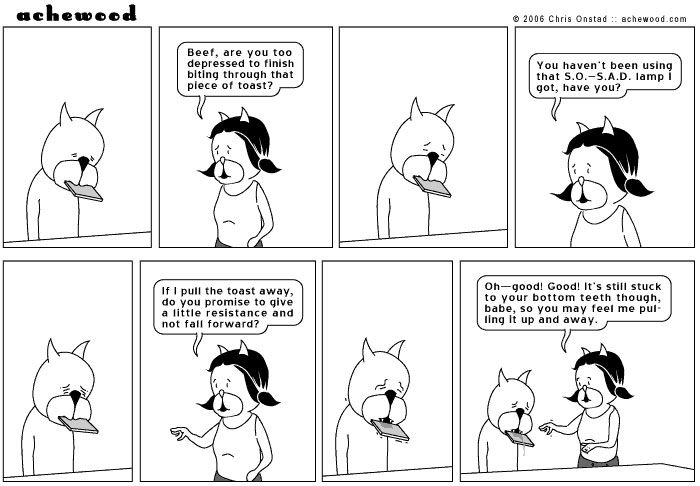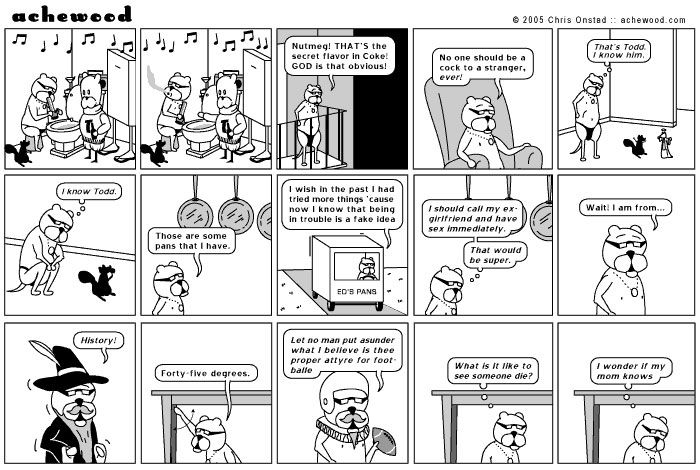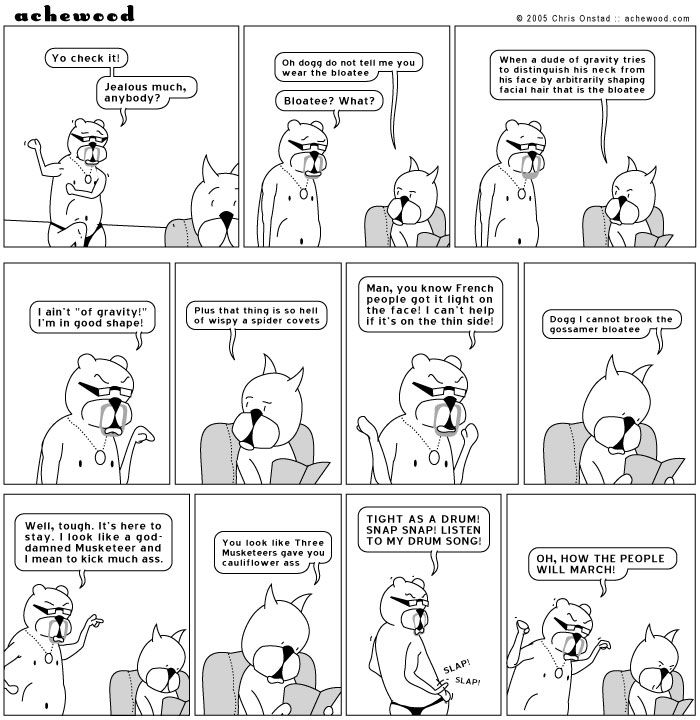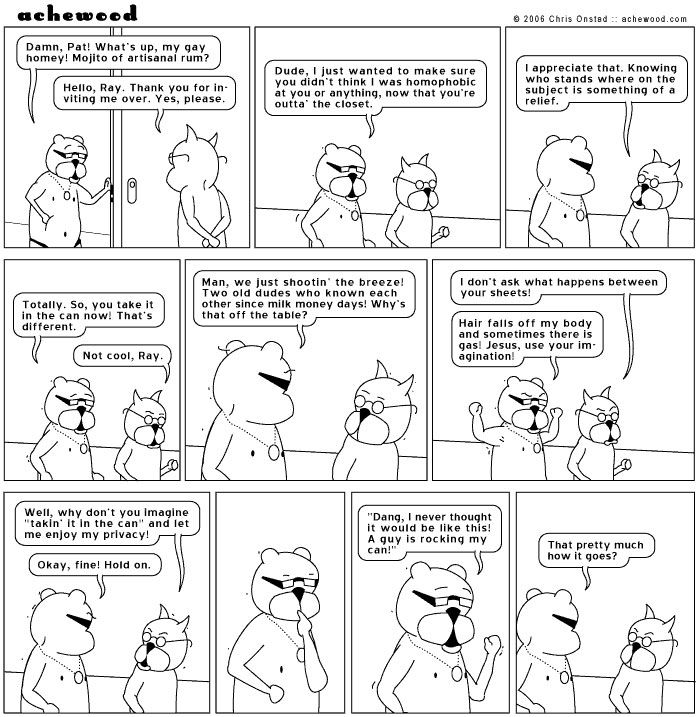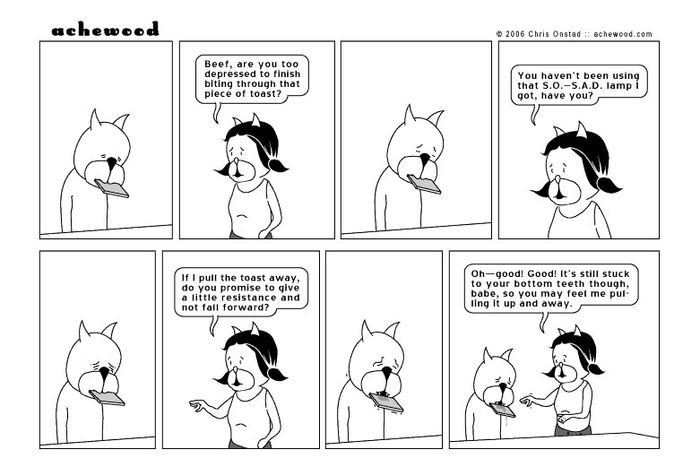
Looking for some quality comedy entertainment to check out? Who better to turn to for under-the-radar comedy recommendations than comedians? In our recurring series “Underrated,” we chat with writers and performers from the comedy world about an unsung comedy moment of their choosing that they think deserves more praise.
A decade before BoJack Horseman gave us anthropomorphic animals who were both funny and full of existential dread, there was Chris Onstad’s webcomic, “Achewood.” Set in the titular fictional town, the comic centered mostly on two protagonist cats: Ray Smuckles, a wealthy hedonist full of optimism and confidence, and his best friend, Roast Beef, who is often introverted and depressed. They were surrounded by characters like the young otter Philippe, elder statesman Cornelius Bear, sensible Molly Sanders, and Pat, who aimed to feel superior to the other characters and had Crohn’s disease. The comic’s distinctness came not only from the depth of the characters but the stylistic choices made by Onstad, who used minimalistic black-and-white drawings, played with font and punctuation, and invented new words and phrases (like “sass gut”) to bring his creations to life.
After it debuted in 2001, “Achewood” earned a cult fan base that appreciated Onstad’s ability to create a comic full of comedy and pathos. As the years went on, Onstad began taking sporadic breaks from the webcomic until seemingly retiring the series in 2016; the last strip was posted to the “Achewood” website on Christmas that year. But the comic’s fan base still lives on through Reddit posts, Onstad’s Twitter, nearly every list of the best webcomics ever, and the occasional online tributes.
Comedian Jes Tom has been an “Achewood” fan since they were a teenager, and their upcoming New York Comedy Festival solo show, Less Lonely, tackles themes that overlap with Onstad’s work: sex, death, gender transition, and being alone during the apocalypse. Tom says the webcomic influenced them not only in how the characters saw one another but how they moved. Their small gestures — like the tiniest cock of any eyebrow — had a big impact on Tom and their comedic sensibility. Tom recently discussed their love for “Achewood,” queer representation in the media, and which character from the comic they relate to most.
I had never heard of “Achewood” before but quickly found it has a passionate fan base. How did you discover it?
I must have discovered “Achewood” in high school or college — during a time that I was reading a lot of webcomics. Webcomics kind of had a moment in the mid-aughts, and I was really in that. As a comedian, I’m much more influenced by things like webcomics than by people doing stand-up.
It seems to match your persona onstage: dry and direct.
That’s me: very dry. I always read comics in the newspaper as a kid. I think that there’s really something about comedic timing that you learn from comics. Comics are so cinematic. It varies moment by moment. It shows you how to draw out the delivery of something to make it as funny as possible.
There was one review I read comparing “Achewood” to Shakespeare in that Chris Onstad was inventing words.
I think that’s what I really love about “Achewood” — how writerly it is. They’re all these very specific characters, and they all have a specific way of talking and relating to each other. It’s a lot of things that I like. I like anthropomorphic animals. (I like animals more than people.) So I like that they are all cats, bears, and otters. I love the weird way that they talk. I’m a person who has a very specific way of speaking, and I’m influenced by things like this.
There’s a character called Roast Beef. We don’t talk about why his name is Roast Beef. His full name is Roast Beef Kazenzakis. He’s Greek, and we don’t know why. It’s totally absurd, but it has its own logic in its own world. It is a training exercise both as a reader, being able to hear characters’ voices when you read them, and as a writer to be able to create characters who have such distinctive voices. It’s kind of a scary comic sometimes. It gets scary, it gets sad, it gets serious, and I’m really into that.
One of the “Achewood” comics you recommended was from 2006, prominently featuring a piece of toast. Why did you choose this one?
I just love this one as an example of what this series is doing. It’s so small. The whole joke of it is that Roast Beef is having these really, really small reactions. His eyebrows go up a little bit. He squints his eyes closed a little bit more. If you look in the last two panels, to me the joke is that you can see his drool starting to drip off of the toast, because he has been holding it in his mouth so long because he’s so depressed. It’s so funny and so sad. It’s a real manifestation of a depression that is relatable to a lot of us. It’s really sweet, because you’re watching this person at the lowest of lows, and he has this person who loves him so much that she’s going to pull the toast out of his mouth.
It’s a great example of how the comic leans toward more subtle punch lines.
I think the punch line is buried in this one. The punch line is that he’s basically doing nothing, and she’s like, “Good! You’re doing great!” He’s doing nothing, and that’s awesome.
Ray getting stoned from 2005 is more all over the place.
Ray getting stoned is awesome, because I am a stoner. It’s just him going around having high thoughts, and that’s it. That it ranges from things that are stupid like “Nutmeg! THAT’S the secret flavor in Coke!” to “What is it like to see someone die? … I wonder if my mom knows.” I just think that one’s classic stoner content.
Ray’s thoughts completely go everywhere. I don’t know why it made me laugh so hard, but his one line (“Those are some pans that I have”) when he’s gazing at his pans in the kitchen got me.
It’s about the little profundities of being stoned — things that are total nonsense to things that are, like, “I wish in the past I had tried more things, ’cause now I know that being in trouble is a fake idea.” In my life currently, I’ve been contending with my own anxiety about getting in trouble, then I saw this and was like, Oh yeah, being in trouble is a fake idea.
Do you see overlap between “Achewood” and your own comedy?
I think so. I feel very influenced by the way “Achewood” is this very minimalist comic. The art style is extremely minimalist, and a lot of the movements are extremely minimalist, but the writing is lush, full, and particular, and I think that is how my stand-up is or has classically been. I identify with the small font of “Achewood.” The way they express things in a small way — I think that’s how I express myself.
The “gossamer bloatee” was one of my favorites.
I love that one. Obviously, now through our current eyes, I’m like, Okay, at its core, it’s a fatphobic joke. And now it takes on this additional meaning to me, because in the comic, they’re talking about the idea that an overweight guy grows a goatee to change the shape of his face. But I really identify with it as a transmasculine person. What we’re doing a lot of the time is growing this gossamer facial hair that we have to keep because we’re like, This is my precious facial hair. It’s so important to the way that I get perceived that I have to keep this facial hair. So a lot of us have really goofy, stupid-looking facial hair, because we refuse to shave it and because it’s so important to our identities and the way we see ourselves. I have this ridiculous pervert mustache, a little soul patch that I’m not going to get rid of. I look like fucking V for Vendetta. And I’m not going to get rid of it. I think that it’s basically the same as this argument they’re having in the comic about the goatee.
There’s so much to mine from each panel.
It’s all the little things in this comic. Roast Beef speaks in a smaller font, and it does so much to build the character.
And there’s no punctuation for Roast Beef.
It just gives them such a specific voice. It gives the two of them a kind of dynamism that I think wouldn’t be there otherwise. It shows how a little choice gives the character a distinctive voice. I love this one, because at its core, it’s an argument about men feeling insecure, which is a universal experience. But they’re talking about it with such specificity.
There’s no backing down from Ray to the end.
That’s Ray’s declaration of his masculinity. He’s slapping his ass. Ray is a cat who wears glasses and a thong and a big chain. He’s slapping his ass and saying his ass is tight as a drum. That’s him declaring his manhood.
Ray and Pat have an interesting back-and-forth in this comic from 2006. Ray’s checking to see if Pat thinks he’s homophobic.
I think this one is so interesting, because it’s 2006 when this comic was posted. It’s just a whole other landscape for queer representation in the media. Not to give a cookie for something really small, but I think it’s a big deal that Pat is gay. He comes out as gay in the series. I don’t think he starts out as gay. He’s just sort of the sourpuss character, then eventually, he comes out as gay, and that contextualizes and textures why he is the way he is. Which is, like, He’s a fucking asshole. He’s a bitch. He’s always critiquing and tearing everybody else down. And now you’re like, Oh, he’s a bitchy old queen — that’s why he’s like that.
It’s a 2006 comic about a straight man trying to support his gay friend, and he’s being so crass and offensive, but that’s the way he supports him. It’s really sweet and funny. In the second to last panel — “Dang, I never thought it would be like this! A guy is rocking my can!” — that’s Ray demonstrating a deep open-mindedness, actually, and an attempt at empathy that is so funny. It’s so funny how he’s pissing Pat off this entire time while he’s trying to be supportive.
The intentions are good, but what comes out is crass. It’s so up front.
Right — it’s very of its time. It’s very mid-aughts. We’ve come all the way around on political correctness now. They don’t talk like this on TV now. There are all these TV shows with queer characters, but they’re not having this kind of candid conversation. I would love for there to be more of this in media — with queer characters being more real and not afraid of being offensive. The offensiveness is the joke. That’s that character’s point of view. He’s trying to be helpful. It’s funny.
On the subject of queer conversations, do you feel like TV shows now are portraying what they want it to look like rather than what it actually looks like?
There’s a real trend right now of trying to make this kind of feel-good representation media that’s like, We’re queer people, we’re all happy, we have friends, and I’m having this meaningful conversation with my mother where she tells me she’ll always love me the way I am. I find it very saccharine. It’s not for me. I like things that are abrasive, that have conflict, that are sweet at the heart. At the heart of “Achewood,” this is a wholesome, heartwarming comic about a straight man, a cat man, who is just trying to relate to his childhood friend who he now knows is gay and is pissing him off.
Which character from “Achewood” do you relate to the most?
I was thinking about that. What I really like about “Achewood” … I don’t know if this is exactly what Chris Onstad is doing, but to me, it seems like it’s all of the extremes. Each character is an extreme that the same guy could have. Ray — he’s braggadocious, hedonist. Roast Beef has deep depression. Pat is gay and judgmental. Lyle has rage. Philippe, the little-boy otter, is naïve and positive. That is what’s appealing about the comic: You can relate to all of them. They’re all just different parts of you at their most extreme. I think I’m probably a Ray and a Roast Beef though, insofar as they’re foils to each other. Ray is this hedonist pervert to Roast Beef’s deep depression. It’s pure self-confidence with a horrible self-worth at the same time.
This interview has been edited and condensed.
More From This Series
- F Is for Family: Bill Burr’s Love Letter to the ’70s
- It’s Time to Appreciate SNL’s ‘Riley’ Sketch, Bitch
- Take a Bite Out of Horowitz & Spector


